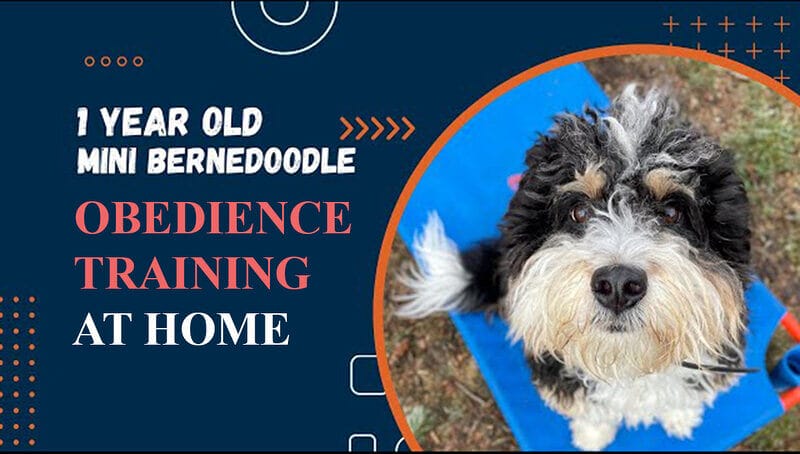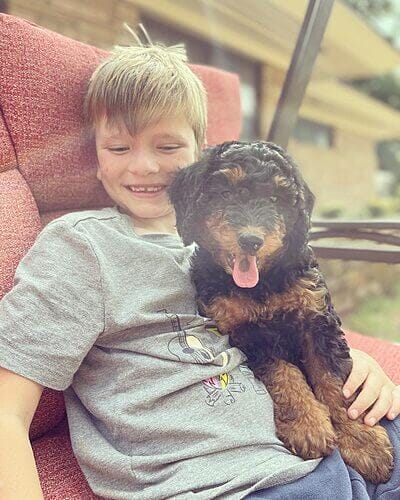Unleash the Good Boy Within: Bernedoodle Obedience Training at Home

“Dogs are not our whole life, but they make our lives whole.” – Roger Caras
Welcome to the wonderful world of Bernedoodles! These adorable, fluffy companions are known for their intelligence, loyalty, and playful personalities. But just like any puppy, Bernedoodles need Bernedoodle obedience training at home to become well-adjusted, happy members of your family.
This comprehensive guide will equip you with all the knowledge and tools you need to successfully train your Bernedoodle puppy. Whether you’re a new Bernedoodle owner or struggling with some Bernedoodle behavior problems, this guide will help you transform your furry friend into a well-mannered companion.

But before we dive in, are you curious about other aspects of Bernedoodle life? Perhaps you’re wondering about Bernedoodle socialization tips to ensure your pup thrives in different environments. Maybe you’d like to learn more about common Bernedoodle training challenges and solutions. Or perhaps you’re simply looking for information on finding the best dog food for your growing Bernedoodle. Fear not! This guide will touch upon these crucial aspects of Bernedoodle care alongside the core training principles.
Now, let’s embark on this exciting journey of Bernedoodle obedience training at home!
Why Train Your Bernedoodle?
Investing time and effort in Bernedoodle obedience training at home reaps numerous benefits for both you and your pup. A well-trained Bernedoodle is:

- Safer: Basic commands like “sit,” “stay,” and “come” ensure your Bernedoodle responds appropriately in various situations, minimizing safety risks like running into traffic.
- Happier: A trained Bernedoodle understands expectations and boundaries, leading to reduced anxiety and frustration. This fosters a more relaxed and content pup.
- More manageable: Imagine a calm walk on a loose leash instead of a frantic tug-of-war.
- Bernedoodle obedience training at home fosters better communication and makes everyday tasks like walks and playtime more enjoyable.
- Stronger bond: The training process strengthens your bond with your Bernedoodle. As you work together, trust and respect deepen, creating a lifelong connection.
Bernedoodle obedience training at home can also address common behavior issues like excessive barking, jumping, chewing, and digging. Addressing these issues early on prevents them from becoming ingrained habits and creating frustration in the future.
Bernedoodle Obedience Training at Home Essentials
Before diving into specific commands, let’s establish some foundational principles for successful Bernedoodle obedience training at home.

Understanding Bernedoodle Development Stages: Like all puppies, Bernedoodles go through different developmental stages. Tailoring your training approach to their age and maturity level is crucial. Generally, puppies have shorter attention spans, so keep training sessions brief and engaging.
Positive Reinforcement vs. Punishment-Based Training: Bernedoodle obedience training at home should be a positive experience. Reward good behavior with treats, praise, or playtime. Punishment-based training can be counterproductive, leading to fear and anxiety.
Importance of Socialization for Bernedoodles: Socialization exposes your Bernedoodle puppy to different people, animals, and environments. This helps them become comfortable in various situations and reduces the likelihood of fear-based behaviors later on.
Getting Started with Bernedoodle Training
Now that you’re armed with the essentials, let’s get started with Bernedoodle obedience training at home!
Essential Training Supplies:
- High-value treats: Invest in small, delicious treats that motivate your Bernedoodle. Consider healthy options like freeze-dried meats or small pieces of their best dog food.
- Leash and collar: Choose a comfortable, well-fitting leash and collar for leash training.
- Clicker (optional): Clicker training can be a helpful tool for marking desired behavior.
- Toys: Use engaging toys to reward good behavior and keep training sessions fun.
Setting Up a Dedicated Training Space: Find a quiet, distraction-free area in your home for training. This minimizes distractions and allows your Bernedoodle to focus on learning.
Creating a Training Schedule and Routine: Consistency is key! Establish a regular training schedule with short, frequent sessions (ideally 5-10 minutes) throughout the day. This keeps your Bernedoodle engaged and prevents them from getting overwhelmed.
Basic Bernedoodle Obedience Commands
Let’s delve into the essential commands for Bernedoodle obedience training at home:
Hold a treat near your Bernedoodle’s nose and slowly move it upwards over their head.
- s they follow the treat with their head, their body will naturally lower into a sitting position.
- The moment their bottom touches the ground, say “Sit!” and reward them with the treat and praise.
- Repeat this process until your Bernedoodle consistently associates the hand signal and verbal cue with the “sit” command.

Stay:
- Have your Bernedoodle in a sitting position.
- Hold your palm in front of their face to signal “stay.”
- Take a small step back. If they remain seated, reward them with praise and a treat.
- Gradually increase the distance and duration of the stay command as your Bernedoodle masters it.

Come:
- Get your Bernedoodle’s attention with a fun cue word like “here” or “come.”
- Take a few steps back with a treat in your hand, encouraging them to follow you.
- As they approach, reward them with the treat and praise.
- Practice this command in different locations and with varying distractions to ensure reliability.

Down:
- Have your Bernedoodle in a standing position.
- Hold a treat close to the ground and slowly move it forward, encouraging them to follow with their nose.
- As their chest touches the ground, say “Down!” and reward them with the treat and praise.
- Practice transitioning from “Sit” to “Down” to create a smooth sequence.

Leave It:
- Place a treat on the ground and hold your palm out in a stop sign position.
- Say “Leave it” before your Bernedoodle attempts to take the treat.
- If they resist the temptation and look at you, reward them with a different treat and praise.
- Gradually increase the difficulty by using more tempting treats or placing them closer to your Bernedoodle.
Bernedoodle Obedience Training at Home: Some Bernedoodles may exhibit leash reactivity towards other dogs or people. If this occurs, consult a professional dog trainer for personalized guidance.
- Mental Stimulation Activities for Intelligent Bernedoodles: Bernedoodles are intelligent dogs who thrive on mental stimulation. Incorporate puzzle toys, food dispensing toys, and scent work activities into your Bernedoodle’s routine to keep them mentally engaged and prevent boredom-induced behavior problems.
- Teaching Tricks and Fun Commands: Once your Bernedoodle has mastered the basic commands, you can move on to teaching them fun tricks like “shake,” “roll over,” or “play dead.” This keeps training sessions engaging and strengthens your bond.
Troubleshooting Common Bernedoodle Training Issues
Biting and Chewing Behavior:
- Provide your Bernedoodle with plenty of appropriate chew toys to redirect their chewing instincts. Choose durable, safe options like rope toys, chew rings, or kongs stuffed with treats.
- Supervise your Bernedoodle closely during playtime and redirect them to a chew toy if they start chewing on inappropriate objects.
- Apply a bitter apple spray (safe for dogs) to deter chewing on furniture or other off-limits items.
Barking and Excessive Vocalization:
- Identify the trigger for your Bernedoodle’s barking. Are they seeking attention, bored, or feeling threatened?
- Address the underlying cause. If they bark for attention, ignore the barking and only reward them with attention when they’re quiet. If they’re bored, provide them with mental stimulation activities.
- Teach your Bernedoodle a “quiet” command. When they bark, say “quiet” in a calm voice and reward them with a treat when they stop barking.

Jumping and Counter-Surfing:
- Don’t greet your Bernedoodle with excitement when you arrive home. Wait for them to calm down before acknowledging them.
- Teach your Bernedoodle an “off” command. When they jump on you, say “off” in a firm voice and turn away from them. Reward them with praise when they have all four paws on the ground.
- Block access to counters with tall baby gates or by removing tempting items within reach.
Ending FAQ
Q: At what age can I start training my Bernedoodle puppy?
A: You can begin Bernedoodle obedience training at home as early as 8 weeks old. Start with short, positive sessions focusing on socialization and basic commands like “sit” and “stay.”
Q: How long do Bernedoodle training sessions need to be?
A: Keep training sessions short and engaging, ideally 5-10 minutes at a time. Puppies have short attention spans, so frequent, shorter sessions are more effective than long, drawn-out ones.
Q: What should I do if my Bernedoodle isn’t responding to commands?
A: There could be several reasons. Ensure you’re using clear verbal cues and hand signals. Make sure the training environment is free from distractions. Review your training methods and consider consulting a professional dog trainer for personalized guidance.
Q: When should I consider professional dog training for my Bernedoodle?
A: Consider professional dog training if you’re experiencing significant challenges with your Bernedoodle’s behavior or if you simply want additional guidance and support. Professional trainers can tailor a training plan to your specific needs and help you achieve your desired results.
Conclusion
Bernedoodle obedience training at home is a rewarding journey that strengthens your bond with your furry friend. By following these tips, consistency, and positive reinforcement, you can raise a well-behaved, happy Bernedoodle who becomes a cherished member of your family. Remember, patience and a positive attitude are key!
Additional Resources:
- American Kennel Club (AKC): https://www.akc.org/
- Association of Professional Dog Trainers (APDT): https://apdt.com/
- List of Bernedoodle Training Centers in the US (to be populated by you based on your research)
Remember to replace the bracketed information with the appropriate details. I hope this comprehensive guide empowers you to embark on a successful Bernedoodle obedience training at home journey!
Petscaretip – How To Care Your Pets
Address: 809 Dallas St, Houston, TX 77002, USA, Houston, TX, United States, Texas
Email: [email protected]










